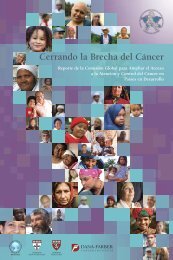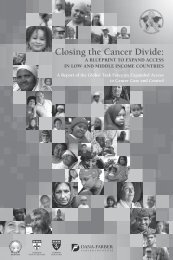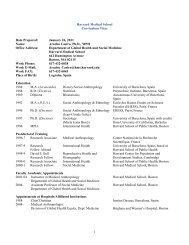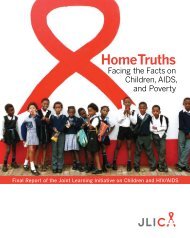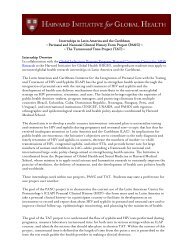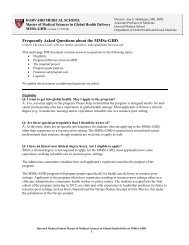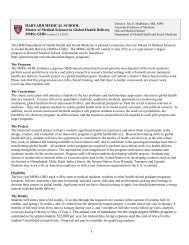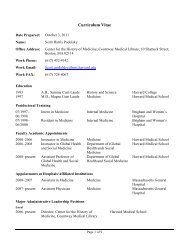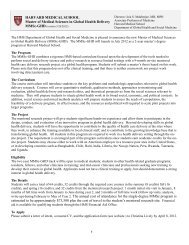Haiti Case Study - The Department of Global Health and Social ...
Haiti Case Study - The Department of Global Health and Social ...
Haiti Case Study - The Department of Global Health and Social ...
You also want an ePaper? Increase the reach of your titles
YUMPU automatically turns print PDFs into web optimized ePapers that Google loves.
Figure 3: Graph <strong>of</strong> Fatalities reported versus days since incident<br />
5. <strong>The</strong> first step occurred immediately, during the actual earthquake (i.e. those caught in<br />
collapsing building who were crushed instantly); the second step occurred later 117 when open<br />
wounds became infected, untreated compound fractures became gangrenous, tetanus set in,<br />
untreated crush injuries caused renal failure, etc. <strong>The</strong>se delayed fatalities, caused by<br />
earthquake-related injuries but leading to death several weeks after the disaster, were the<br />
result <strong>of</strong> delayed access to health-care facilities.<br />
6. Lack <strong>of</strong> secondary <strong>and</strong> tertiary care capacity made patient triage <strong>and</strong> the setting <strong>of</strong><br />
priorities for care the most important drivers in h<strong>and</strong>ling patients. Delays in care could lead<br />
to worse patient conditions <strong>and</strong> thus tougher medical challenges than would have been<br />
present with timely intervention, especially in those portions <strong>of</strong> the population suffering from<br />
anaemia (caused by malaria), from drug resistant tuberculosis, or from malnutrition whose<br />
underlying poor health status exacerbated their earthquake-related injuries.<br />
7. Immediately following the earthquake, many people with relatively minor (i.e. non-life<br />
threatening) injuries overwhelmed secondary care infrastructures, preventing their<br />
specialized capabilities from being used appropriately, while primary care facilities were<br />
overwhelmed by patients with injuries too complex to be h<strong>and</strong>led. In some instances,<br />
primary care facilities’ only option was to treat patients urgently despite scarcity <strong>of</strong> tools <strong>and</strong><br />
medical staff expertise 118 . Other patients were lucky enough to be transferred to a suitable<br />
facility, but arranging these transfers was a distraction for medical staff, which lost precious<br />
time for addressing acute care needs.<br />
8. A longer-term challenge came from financial arrangements for externally provided<br />
health care: would <strong>Haiti</strong>ans have to pay directly for the care they received or would it be<br />
provided to them free <strong>of</strong> charge? Before the earthquake, most services <strong>of</strong>fered by MSPP<br />
required user payment. 119 As a result, many <strong>Haiti</strong>ans had difficulties accessing public health<br />
since most <strong>of</strong> them live on two dollars or less per day. After the earthquake, a wide range <strong>of</strong><br />
NGOs <strong>and</strong> other international actors, with total funds which far exceeded the MSPP<br />
budget 120 , were able to <strong>of</strong>fer many free medical services. This “shift <strong>of</strong> power” from state to<br />
externally provided health services undermined the national health system.<br />
9. Responders needed to incorporate the system <strong>of</strong> temporary medical treatment facilities<br />
established by numerous civilian <strong>and</strong> military actors into an effective care network with<br />
existing medical treatment facilities. This was needed to both meet the immediate medical<br />
needs <strong>of</strong> the population <strong>and</strong> promote reconstruction <strong>and</strong> development <strong>of</strong> <strong>Haiti</strong>'s medical care<br />
network to meet local needs long-term.<br />
B-2



